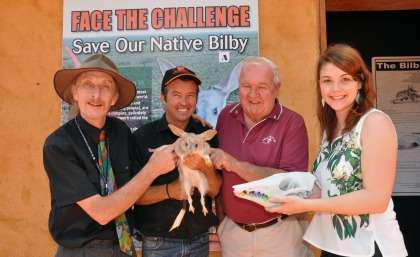Bilby toothache answered by advanced technology

Scientists have gained a better understanding of severe dental problem in bilbies and how to treat them by using advanced CT scans and 3D printed models.
Dental problems put an additional strain on already endangered captive bilby colonies.
To help return the much loved native to better health, the not-for-profit Save the Bilby Fund sought the help of wildlife biologist Dr Steve Johnston, and animal scientist Dr Simon Collins, from The University of Queensland.
Delighted by the request, Dr Johnston and Dr Collins used a highly innovative method of imaging, commonly used in human medicine, to explore the dental pathology of the bilby.
Their focus started with a captive population at the Gold Coast theme park, Dreamworld, comparing these animals to specimens at the Queensland Museum.
Dr Collins said CT scans of four bilbies from the Dreamworld colony were performed at the Veterinary Medical Centre at UQ's Gatton campus.
"From these scans, we constructed 3D models of the skull and teeth using Mimics Software," Dr Collins said.
"Our collaborators in the Department of Anatomy & Developmental Biology at Monash University produced real life upscale models of the skull and teeth using a 3D printer.
"The skull models can now be used by veterinary dentists to assess any pathology and develop strategies to remove the teeth safely."
Dr Johnston and Dr Collins have successfully identified and described the pathology of the captive bilbies and are now looking for the cause of the dental problems.
"We believe the main issue is likely to be associated with the bilbies' diet, but we need to look at more wild animals to be certain," Dr Collins said.
"The wildlife carers at Dreamworld do a great job of caring for these animals, but we can always improve on our understanding of best practice."
The project has provided a unique research experience for Samantha Nixon, a second year UQ biomedical science student in the Advanced Studies Program in Science who scanned bilbies and constructed models of the cranial anatomy and dentition.
"Wildlife conservation has always been my passion and researching dental pathologies in the bilby has been an exciting experience," said Ms Nixon.
"Seeing the way scientific research and clinical practice is integrated in a real-world environment has been a fantastic learning opportunity and inspired me to continue work in this field."
Finding a cause for the dental problems is the next step in ensuring the continuation of the captive and wild populations.
Increasing bilby conservation in Queensland is now critical, after approximately 150 newborn bilbies were exposed to predators such as foxes and feral cats when a purpose-built bilby fence in remote western Queensland was damaged by floods in early 2013.
Dr Johnston said the technology used in this research was already being put to other uses at the University.
"We are delighted that we can use this advanced imaging technology to not only solve specific veterinary problems, but also incorporate the models into our animal science courses– we plan to implement the new 3D technology as early as next year into our 2nd year anatomy courses at UQ Gatton," said Dr Johnston.
Dr Collins and Dr Johnston have also used the CT scans and models to investigate toothware in the koala and wombat, to describe the vocal anatomy of both species and recently to document the musculo-skeletal system of the salt-water crocodile.
Provided by University of Queensland



















